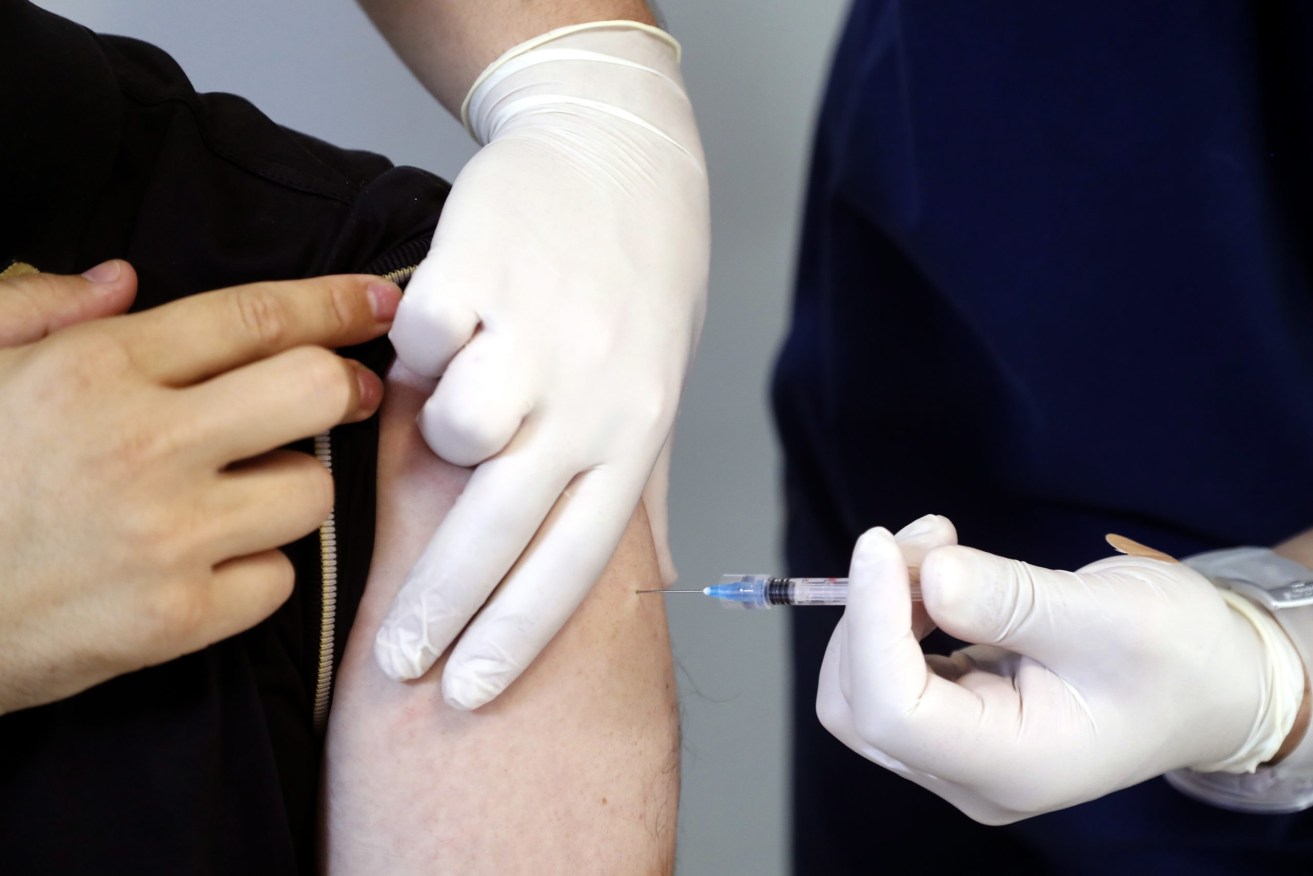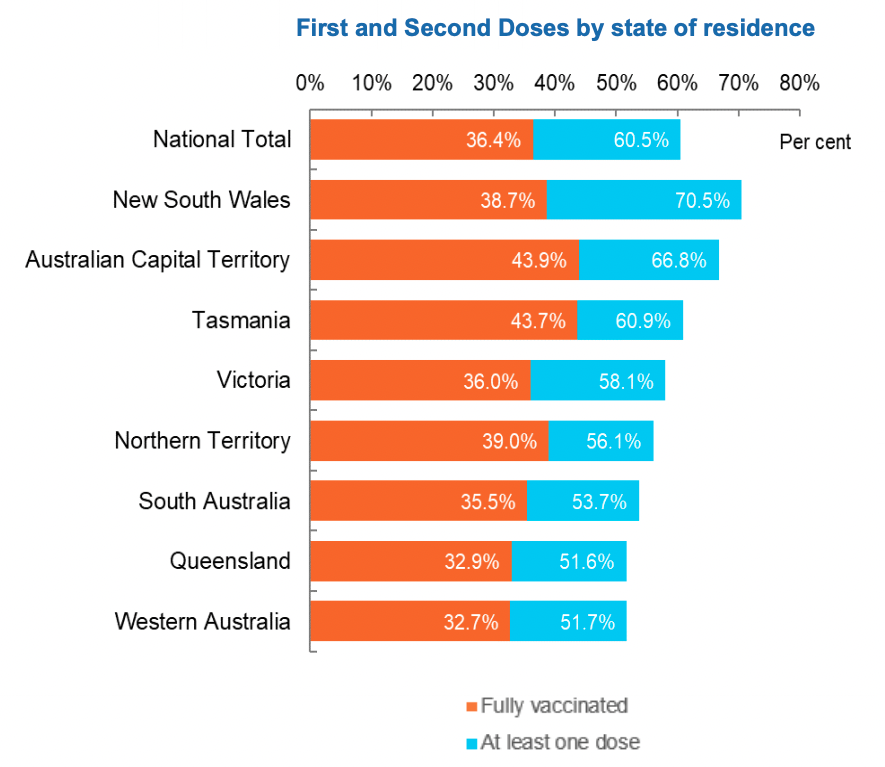Vaccine supply slows march to SA target
South Australia’s progress towards reaching its target to fully vaccinate 80 per cent of the over-16 population against COVID-19 has been hampered by distribution of supply across states and territories, SA Health and a leading epidemiologist say.

Photo: Zurab Kurtsikidze/EPA
Latest federal government data released yesterday shows South Australia has the third lowest vaccination rate in the country, with only Western Australia and Queensland lagging behind.
The data shows 53.7 per cent of South Australians aged over 16 have received their first vaccination dose, while 35.5 per cent are fully vaccinated.
Compared to other states, South Australia has the lowest vaccination rate for the over 50 cohort, with less than half that population being fully vaccinated, despite older South Australians being prioritised in the vaccination rollout.
An ABC analysis shows South Australia will be the last jurisdiction in Australia to have 80 per cent of its adult population at least partially vaccinated against COVID-19.
According to the analysis, South Australia will reach the target by November 3, behind nation-leader New South Wales, which is estimated to have 80 per cent of its adult population partially vaccinated by September 11.
But a separate analysis by The Guardian Australia shows South Australia is tracking much better when it comes to fully vaccinating adults, with SA expected to have 80 per cent of its adult population double-vaccinated by late November – slightly ahead of Victoria.
The country’s leaders are waiting until 80 per cent of the country is fully vaccinated before they start easing restrictions and opening up state and territory borders, in line with modelling from the Doherty Institute.

Image: Federal Government. Data published September 2 2021
SA Health deputy chief executive Don Frater told a parliamentary committee hearing yesterday that the eastern states were tracking much better than South Australia at administering first dose vaccines.
He said South Australia was instead “chugging through both first and second doses in the normal timeframes”.
“What we are obviously not achieving is the significant increase in first doses that you’re seeing especially in New South Wales,” he said.
“We are on second doses roughly the same as Victoria.”
Frater said the “real issue” for South Australia was not the speed of the vaccine rollout, but supply.
He said South Australia received 50,000 extra doses of vaccine out of the Federal Government’s deal with Poland, while New South Wales obtained 500,000 doses, on top of an additional 500,000 doses in “bring forwards and special vaccine supply by the Commonwealth”.
“They (New South Wales) are a population four and a half times ours, so it makes it somewhat hard when there is a league table when there is such a discrepancy on vaccine supply,” he said.
Frater said between 16,000 to 18,000 South Australians were getting vaccinated at state and federal-run clinics each day, with SA Health responsible for administering between 6000 to 7000 of those doses.
“We are still aiming for 70 to 80 per cent (vaccination rate) in November of (people aged) 16-plus,” he said.
University of South Australia epidemiologist Professor Adrian Esterman told InDaily that South Australia “clearly doesn’t have enough vaccine” to meet demand.
But he said the supply issue might be resolved in the coming weeks once the state receives supplies of the Moderna vaccine.
“My best guess is that South Australia will probably catch up over the next few weeks,” he said.
“It’s a bit difficult at the moment because there’s a bit of a push to give Victoria and New South Wales more vaccine because they’re in more trouble.
“Up until now, they’ve distributed vaccine per capita, but I know that there is some talk of giving greater supply to New South Wales at the moment and potentially Victoria.
“In a sense that’s fair enough because what happens in those two states affects the other states.”
It comes after Prime Minister Scott Morrison announced that Australia had struck a deal with the United Kingdom to receive four million doses of the Pfizer vaccine.
He said the agreement meant the number of Pfizer doses arriving in Australia this month would double.
The Government has promised to distribute the extra doses to states and territories based on population.
Meanwhile, the State Government has changed its regulations to allow final year students studying nursing, midwifery, medicine, paramedicine or pharmacy to administer COVID-19 vaccines.
Health Minister Stephen Wade said the change was made to ensure South Australia had a sufficient workforce to meet demand.
“We know there will be an increased supply of COVID-19 vaccines flowing into South Australia in the coming weeks and months, and this initiative is boosting our workforce to meet the demand to vaccinate our state and keep South Australians safe,” he said.
“These temporary changes to South Australia’s Controlled Substances Legislation will enable SA Health to employ suitably qualified health practitioner students to work in our vaccination clinics as part of the vital workforce to support the timely, efficient, and safe delivery of COVID-19 vaccinations to the South Australian community.”
Wade said SA Health was currently working out a “model of care”, which would outline specific requirements, training, supervision and responsibilities for the students employed in State Government vaccination clinics.
He said students in their final year of study towards becoming a registered nurse would soon be invited to apply for the “student nurse – immuniser and testing surveillance” role.
“Giving every South Australian access to the lifesaving vaccine is a priority of the Marshall Liberal Government and we are doing everything we can to scale up our rollout by opening more appointments, more clinics and further boosting the workforce available to deliver the vaccine,” he said.
New South Wales today recorded 1431 new coronavirus cases and 12 deaths, including a woman in her 30s, who died at her home.
Victoria recorded 208 new cases this morning and another death.
– With additional reporting by Thomas Kelsall




